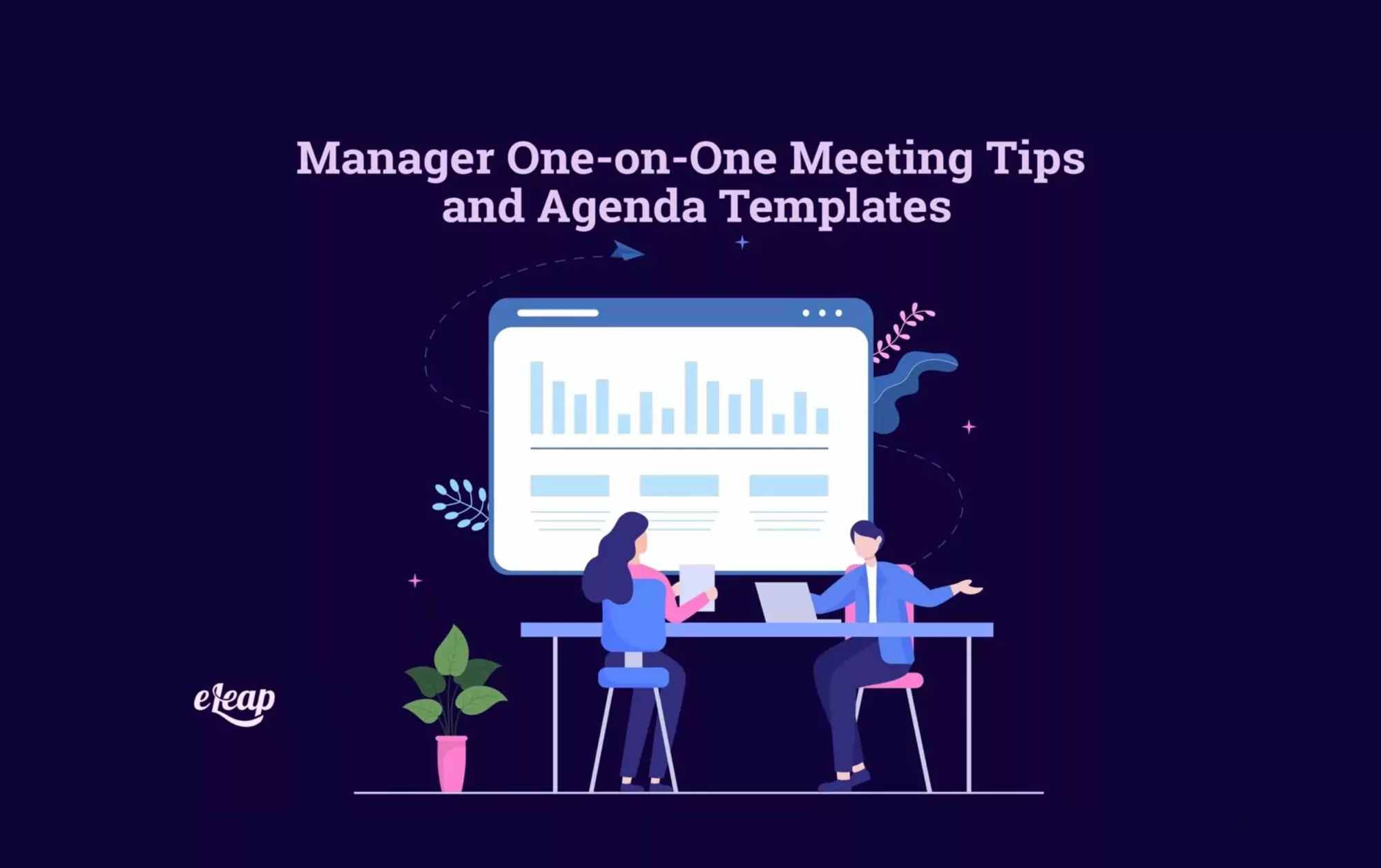Manager One-on-One Meeting Tips and Agenda Templates

Workplace teams cannot be successful without good communication and time management of meetings, and agenda templates are pivotal components of both. They provide a framework on which to base the structure of various types of meetings so that both the employee and manager’s time is spent as productively as possible. Though manager one-on-ones are meetings that take place between only two people, agenda templates can still be beneficial to their success.

What is a Manager One-on-One?
Thinking about having a one-on-one meeting with your manager can be intimidating. Most people would probably rather do anything else than face that kind of intense scrutiny. However, if you’re a genuinely good employee who always puts their best foot forward at the office, you should have little to worry about when meeting one-on-one with your manager. From the opposite perspective, managers should be excited to meet with the employees they supervise to gain more perspective and insight on the tasks executed regularly, as well as any unresolved issues that may be looming over the team.
A one-on-one meeting is relatively self-explanatory, given that it’s a meeting between two individuals, and when it’s conducted in the workplace, typically takes place between a manager and a subordinate employee. These meetings can feel more casual in that sometimes two people can tend to get off topic more easily than in a room full of team members in a traditional meeting, the main reason agenda templates can be helpful, even for manager one-on-ones.
Agenda Templates: A Brief Explanation
Agenda templates are, essentially, outlines that explain the topics up for discussion in a meeting. The template lists the topics in the order they are to be discussed, and how much meeting time should be devoted to each topic. The meeting agenda also indicates which team member is responsible for each subject. The agenda template should leave space for notes to be made as the meeting progresses, such as what decisions were made and by whom, and who is responsible for certain tasks or solutions going forward from the meeting. For manager one-on-ones, agenda templates might be a bit more simple but still provide the same necessary guidance for those in the meeting to stay on task.
Benefits of Manager One-On-Ones
Routine check-ins between managers and team members are beneficial for all those involved. The employee can get some feedback and guidance directly from their supervisor, so they always know their exact standing as a part of the team. The meetings result in better connections between managers and employees and help to cultivate working relationships and familiarity between colleagues, which is beneficial for future trust and communication. Hopefully, the exchange of information is always positive, but there may come a time when more difficult topics need to be discussed by either the employee or the manager, and that’s when the safe space created by regular one-on-one meetings becomes the most important.
As for managers, one-on-ones allow them to take a more active role in their employee’s professional development and improve employee retention by getting early access to any issues that need to be resolved. The most successful and productive employees have strong connections to all coworkers in the workplace, management included, but those types of bonds do not just form overnight. It takes time to build that kind of trust and familiarity in a professional relationship. One-on-one meetings are also great opportunities for the manager to also receive and consider feedback, even constructive criticism, that will hopefully inspire them to continue striving to be the best manager possible.
The business will benefit from regular one-on-ones between managers and employees because these meetings typically result in quick problem-solving as well as satisfied and confident employees. These benefits provide the foundation for successful organizations.
Different Types of Manager One-on-One Agenda Templates
There are numerous ways to outline meetings between employees and managers, depending on the needs or goals most relevant to the team at the time. Each type of one-on-one will focus on different types of questions. Consider the following examples:
The Regular Check-In
These types of meetings are meant to be more laid-back, and their main purpose is to help cultivate the relationship between subordinate employees and their managers. Celebrating achievements and resolving issues head-on in these meetings add to the basis of trust between managers and employees. Some prompts that might be on the agenda templates could be:
- How are you doing? How are your first days on the job going?
- What would you like to talk about today?
- What achievements are you currently proud of?
- What conflicts are you trying to resolve?
- How can I best offer you support?
- Any final thoughts for today’s meeting?
All these questions could and should be answered by both the employee and the manager in the one-on-one meeting.
New Employee’s First One-On-One
These initial meetings set the stage for the employee’s time with the company and contribute to foundational trust between coworkers. Great questions for agenda templates for first meetings include:
- What draws you to this role? What draws you to this company?
- What are your professional goals while working in this position?
- Where do you get your energy for work? What types of issues deplete your energy the fastest?
- What is your responsibility to this company and how do I fit into that?
- How does this team work together?
- Discuss the parameters of future one-on-one meetings.
- Ask for any final thoughts.
Goal-Setting Meeting
If an employee is struggling to articulate goals in the workplace, they could benefit from sitting down with their manager to brainstorm new objectives and troubleshoot their goal-setting process. These types of agenda items are all about goal setting with employees:
- Talk about why and how objectives are identified within the organization.
- Ask about how previous objectives were reached.
- Recap any currently relevant company or team priorities.
- Compare current objectives to the employee’s personal development goals.
- Identify what the next steps should be and create an action plan.
One-on-Ones for Employee Growth
Part of ensuring the future success of an organization is inspiring employees to challenge themselves with growth exercises and professional development. Here are a few items to help employees brainstorm how to push themselves to grow professionally and personally:
- What skills or abilities would you like to cultivate more?
- What are the action steps that could bring you closer to reaching that goal?
- What parts of your work are the most motivating to you?
- What parts of your work responsibilities do you enjoy the least? Is there anything frustrating or even a bore to you? If there was one item on your task list you’d prefer never to revisit, what would it be?
- Where do you see yourself in (x) years?
Even though these types of meetings are geared toward motivating the employee to seek more growth opportunities, growth conversations should inspire both the employee and the manager to look forward and set new goals for future development.
One-on-Ones for Performance Improvement
These meetings can be a bit more intimidating or uncomfortable, as both manager and employee are expecting to unpack and discuss any shortcomings the employee may have in terms of their performance. It’s not always easy to receive constructive criticism, but these talking points can help make the meeting both positive and effective:
- Do you feel you have a thorough understanding of the expectations placed on your position? Would you agree that these expectations are reasonable?
- Can you visualize how your position and job duties fit into the grand scheme of the company’s structure and goals?
- Do you feel you’re receiving feedback consistently? What is the best way to communicate feedback to you?
- Do you feel as though you can ask for help when you need it?
- What do you feel got in the way of your performance success?
- What are some action steps or goals that could help you move forward?
As you can see, performance improvement meetings are not about dishing out criticism and punishment. Instead, agenda templates for these meetings should be designed to help make sure the employee has all the information they need to be successful, in addition to helping them to identify any roadblocks as well as solutions with which to move forward.
Conclusion: Ensuring Successful One-on-One Meetings
For routine manager one-on-ones to be successful, everyone must be willing to participate. After reviewing the example topics and questions, it’s easy to see how one-on-one meetings can be useful for a variety of purposes, but for team members to believe in their efficacy, early commitment and consistent participation are a must. It is the responsibility of the leadership team to lay the foundation for a one-on-one culture within an organization. Employees may not stick with it at first without some prompting from their supervisors, but once everyone is on board, manager one-on-ones can be pivotal in building trust between team members and their supervisors. Agenda templates are great tools for keeping all kinds of meetings organized and are no less important in meetings of only two people, so make sure your management team has the right agenda templates for their meeting goals saved and ready to be put into action. The eLeaP continuous performance management system provides organizations with powerful options to attract and retain high caliber team members.